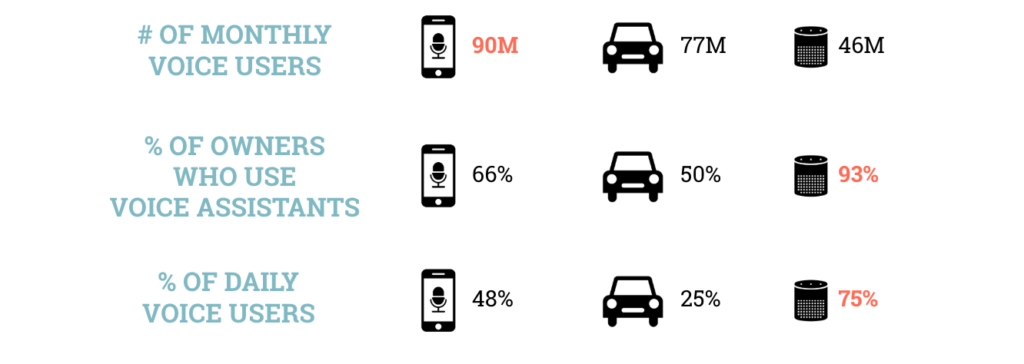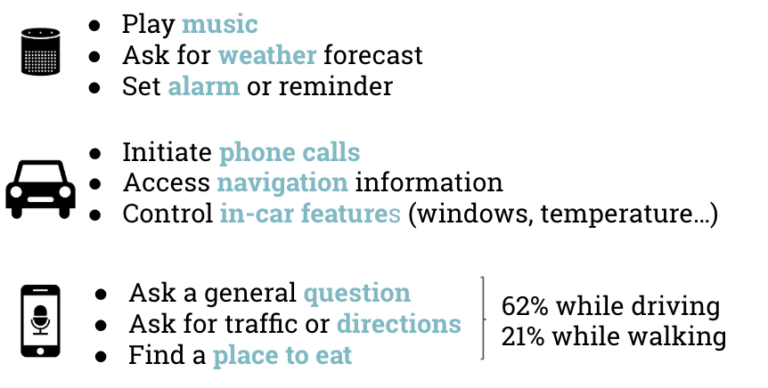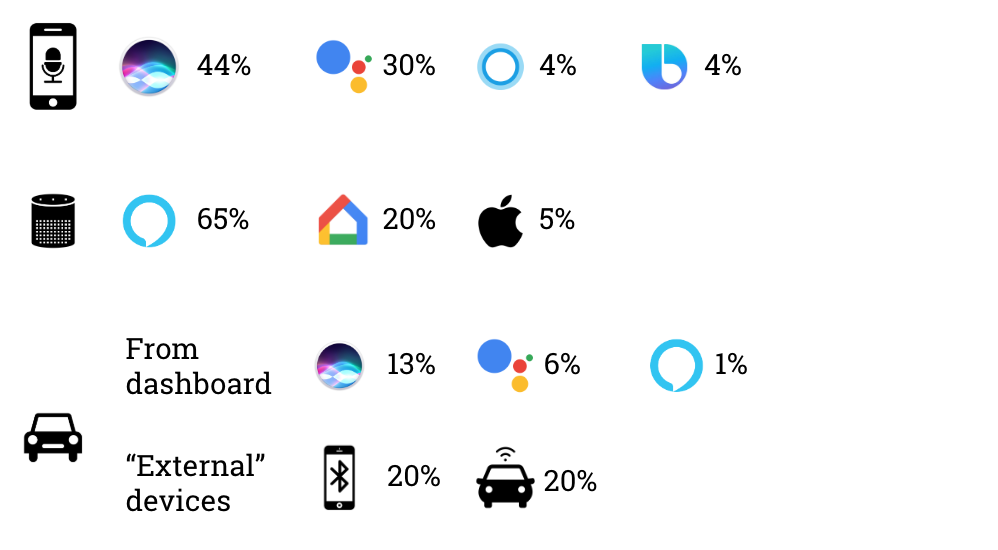
Want to know more about the context in which voice assistants are used?
We have compiled the key facts and figures of existing studies in this quick primer.
Smartphones and cars drive volumes but at-home smart speakers drive engagement
Smartphones and cars top the numbers of monthly users. This is somewhat logical when considering that:
– most smartphones and car natively embed voice assistants
– the penetration of smartphones and car among the population is very high
– smartphones are following their owner everywhere
– Americans spend in average 54 minutes in their car every day
– voice was available in cars as early as 2004, 10 years before the first smart speaker
However, at home users are much more engaged with smart speakers: these are way in the lead when it comes to the proportion of daily use.

Top use cases vary depending on the context

Different contexts, different ecosystems

At home, some locations are preferred for smart speakers
- 44% in the living room
- 38% in the bedroom
- 33% in the kitchen
The car is a complex context for voice interactions
The specifics of driving impact the conversation paths and content :
- Safety comes first, conversation second: at anytime the user might need to quit the conversation and will come back to it later.
- The need for offline use is likely (e.g. in an underground garage, a remote area…)
- The physical environment is challenging for voice recognition because of cabin noise and microphone positioning
- Some use cases are car-specific (e.g. cabin controls, questions about the surroundings)
The multi-layered in-car ecosystem pushes for cross-assistants conversations capabilities
- 76% of drivers are interested in having their in-home voice service in their next vehicle because
- There is no learning curve for the user (66%)
- There is no learning curve for the voice assistant (57%)
- They want seamless experience (49%)
- Tesla registers the worst conversion rate (50%) from trial to monthly use of voice in car because it does not support Apple CarPlay and Android Auto
Voice capabilities: an increasingly high stake for car makers
- 59% of drivers are more likely to buy from a specific car manufacturer if their in-home voice service is available in their car
- 74% among Gen Y
- 79% among Gen Z
Sources
- Voicebot.ai – In-car voice assistant consumer adoption report – January 2019
- Voicebot.ai – Voice Assistant Consumer Adoption Report – June 2018
- State of Voice by Adobe Digital – 2019
- Voice in Vehicles by J.D. Power for Alexa Auto – 2019
- Adam Emfield, Nuance Automotive in Voicebot Podcast 04/15/2019
- Arianne Walker, Amazon Alexa Automotive in Voicebot Podcast 04/15/2019
Want more?
- Watch the replay of our June 2019 meetup on the context of voice with Lisa Falkson and Mihai Antonescu
- Download our 2 pager pdf recap on the context of voice.
About Dashbot
Dashbot is a conversational analytics platform that enables enterprises and developers to understand user behaviors, optimize response effectiveness, and increase user satisfaction through actionable data and tools.
In addition to traditional analytics like engagement and retention, we provide chatbot specific metrics including NLP response effectiveness, sentiment analysis, conversational analytics, and the full chat session transcripts.
We also have tools to take action on the data, like our live person take over of chat sessions and broadcast messaging for re-engagement.
We support Alexa, Google Home, Facebook Messenger, Slack, Twitter, Kik, SMS, web chat, and any other conversational interface.
 /blog
/blog